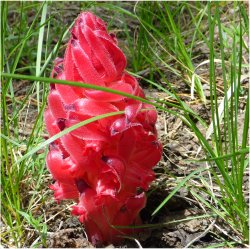
Large-flowered fiddleneck (Amsinckia grandiflora)
displayed at the University of California Botanical Garden in Berkeley (CalDay, April 12, 2014)
Fiddlenecks
are flowering plants with small flowers on a curling stem
reminiscent of the top part of a fiddle. Species identification
is a challenge, since ranges of fiddleneck species may overlap and species
varieties are known to naturally hybridize.
Berkeley's
University of California Botanical Garden
makes it easy to recognize and appreciate a particular species:
the annual large-flowered fiddleneck,
which visitors can study in a featured display near the entrance.
I enjoyed to do so during California Day 2014, trying to
get snapshots of the yellow, orange-tinged flowers while
their fiddleheads were nodding in the wind.
Large-flowered fiddleneck is seriously threatened by competition
from non-native weeds [1-4].
A garden panel with the title “Large-flowered
Fiddleneck—on the Brink of Extinction?”
explains:
The existence of this annual species (Amsinckia grandiflora) in nature is a precarious one. Only one naturally occurring population is known today, on land recently purchased by the Contra Costa Water District near Altamont Pass. The Department of Energy established the 160-acre Amsinckia grandiflora Reserve in 2000 on Lawrence Livermore National Laboratory lands. The population on the reserve persists because lab scientists augment it each year with more seeds.
The Berkely Botanical Garden staff and partners are searching for suitables sites to (re-)introduce large-flowered fiddleneck and to create new populations from seeds produced in the garden.
The scientific name for large-flowered
fiddleneck is
Amsinckia grandiflora.
The species epithet grandiflora
means large-flowered. The generic name
Amsinckia honors the
German businessman Wilhelm Amsinck
(1752-1831), who—from 1802 to 1811—was major
of the city of Hamburg in northern Germany and a benefactor
of that city's botanic garden [5].
Fiddlenecks belong to the family
Boraginaceae, the
borage or
forget-me-not family.
The flowers with their five-lobed calyx
are arranged alongside
the curly inflorescence, the
“fiddle.”
The coarse hairs, which can be seen on the stem and sepals in the
picture above, induce in some people—by contact— an
adverse skin reaction,
such as itching and rash.
References and selected literature
| [1] | Robert Ornduff, Phyllis M. Faber and Todd Keefer Wolf: Introduction to California Plant Life. University of California Press, Berkeley and Los Angeles, California, 2003; pp. 37-38. |
| [2] |
Bruce M. Pavlik, Daniel L. Nickrent
and Ann M. Howald:
The Recovery of an Endangered Plant.
I. Creating a New Population of Amsinckia grandiflora.
Conservation Biology,
Sep.
2003,
7
(3),
pp. 510-526.
PDF: http://botanicalgarden.berkeley.edu/research/Amsinckia/Recovery of an endangered plant_Conservation_Biology_1993.pdf. |
| [3] |
Tina Carlsen, Erin Espeland and Bruce Pavlik:
Restoration of the Large-Flowered Fiddleneck
(Amsinckia grandiflora) at Lawrence Livermoore
National Laboratory Site 300.
Lawrence Livermore National
Laboratory, University of California,
Livermore, California 94551,
UCRL-AR-135516,
Oct.
1999.
PDF: http://www-erd.llnl.gov/library/AR-135516.pdf. |
| [4] | Calflora Taxon Report 323: Amsinckia grandiflora A. Gray. Internet: http://www.calflora.org/cgi-bin/species_query.cgi?where-taxon=Amsinckia+grandiflora. |
| [5] | Wilhelm Amsinck (1752-1831). Internet: http://de.wikipedia.org/wiki/Wilhelm_Amsinck_(1752-1831). |








